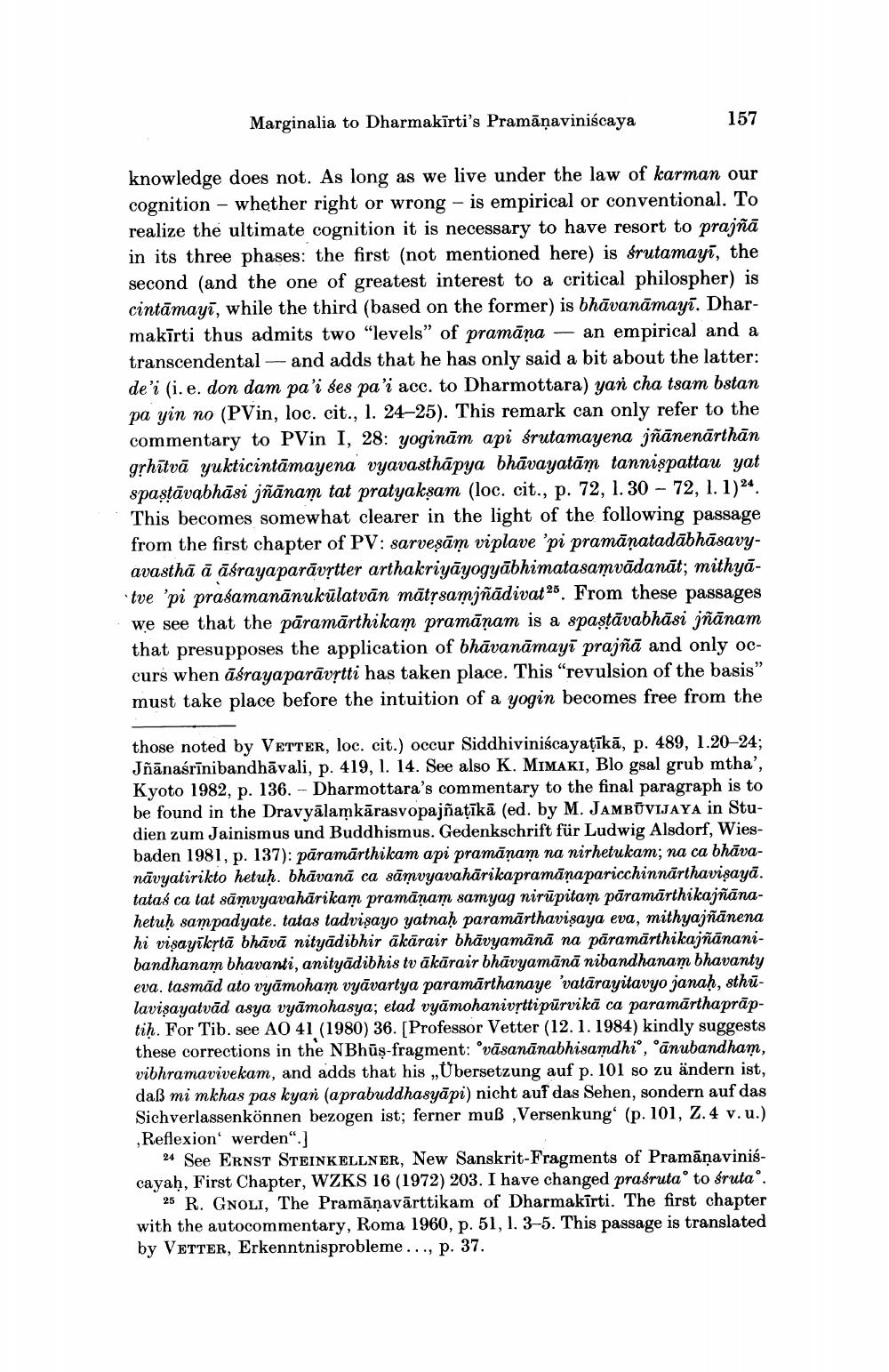Book Title: Marginalia To Dharmakirtis Pramanaviniscaya I II Author(s): Christian Lindtner Publisher: Christian Lindtner View full book textPage 9
________________ Marginalia to Dharmakīrti's Pramāņaviniscaya 157 knowledge does not. As long as we live under the law of karman our cognition - whether right or wrong – is empirical or conventional. To realize the ultimate cognition it is necessary to have resort to prajñā in its three phases: the first (not mentioned here) is srutamayī, the second (and the one of greatest interest to a critical philospher) is cintāmayī, while the third (based on the former) is bhāvanāmayī. Dharmakīrti thus admits two "levels" of pramāna – an empirical and a transcendental -- and adds that he has only said a bit about the latter: de'i (i.e. don dam pa'i ses pa'i acc. to Dharmottara) yan cha tsam bstan pa yin no (PVin, loc. cit., 1. 24–25). This remark can only refer to the commentary to PVin I, 28: yoginām api śrutamayena jñānenārthan grhītvā yukticintāmayena vyavasthapya bhāvayatām tannispattau yat spastāvabhāsi jñānam tat pratyaksam (loc. cit., p. 72, 1.30 – 72, 1. 1)24. This becomes somewhat clearer in the light of the following passage from the first chapter of PV: sarvesām viplave 'pi pramāṇatadābhāsavyavasthā ā āśrayaparāvýtter arthakriyāyogyābhimatasamvādanāt; mithyātve 'pi prasamanānu kūlatvān mātssamjñādivat25. From these passages we see that the pāramārthikam pramāņam is a spastāvabhāsi jñānam that presupposes the application of bhāvanāmayī prajñā and only occurs when āśrayaparāvýtti has taken place. This “revulsion of the basis” must take place before the intuition of a yogin becomes free from the those noted by VETTER, loc. cit.) occur Siddhiviniscayatīkā, p. 489, 1.20–24; Jñānaśrīnibandhāvali, p. 419, 1. 14. See also K. MIMAKI, Blo gsal grub mtha', Kyoto 1982, p. 136. - Dharmottara's commentary to the final paragraph is to be found in the Dravyālamkārasvopajñatīkā (ed. by M. JAMBŪVIJAYA in Studien zum Jainismus und Buddhismus. Gedenkschrift für Ludwig Alsdorf, Wiesbaden 1981, p. 137): pāramārthikam api pramāņam na nirhetukam; na ca bhāvanāvyatirikto hetuh. bhāvanā ca sāmvyavahārikapramānaparicchinnārthavisayā. tataś ca tat sāmvyavahārikam pramāņam samyag nirūpitam pāramārthikajñānahetuḥ sampadyate, tatas tadvisayo yatnaḥ paramārthavisaya eva, mithyajñānena hi visayīkytā bhāvā nityādibhir ākārair bhāvyamānā na pāramārthikajñānanibandhanam bhavanti, anityādibhis tv ākārair bhāvyamānā nibandhanam bhavanty eva, tasmād ato vyāmoham vyāvartya paramārthanaye 'vatārayitavyo janaḥ, sthūlavisayatvād asya vyāmohasya; etad vyāmohanivetti pūrvikā ca paramarthaprāptiḥ. For Tib. see AO 41 (1980) 36. [Professor Vetter (12. 1. 1984) kindly suggests these corrections in the NBhūş-fragment: 'vāsanānabhisamdhi", "ānubandham, vibhramavivekam, and adds that his ,Übersetzung auf p. 101 so zu ändern ist, daß mi mkhas pas kyan (aprabuddhasyāpi) nicht auf das Sehen, sondern auf das Sichverlassenkönnen bezogen ist; ferner muß Versenkung' (p. 101, Z. 4 v. u.) ,Reflexion' werden“.] 24 See ERNST STEINKELLNER, New Sanskrit-Fragments of Pramāņaviniscayah, First Chapter, WZKS 16 (1972) 203. I have changed praśrutao to Srutao 25 R. GNOLI, The Pramāņavārttikam of Dharmakīrti. The first chapter with the autocommentary, Roma 1960, p. 51, 1. 3-5. This passage is translated by VETTER, Erkenntnisprobleme..., p. 37.Page Navigation
1 ... 7 8 9 10 11 12 13 14 15 16 17 18 19 20 21 22 23 24 25 26 27
